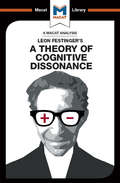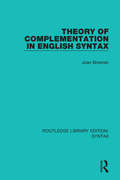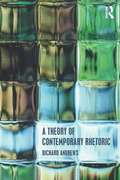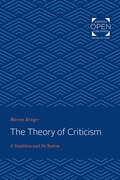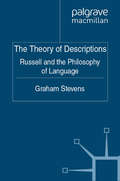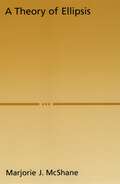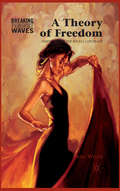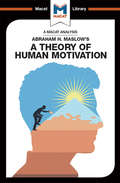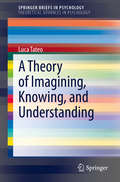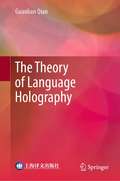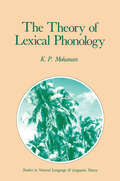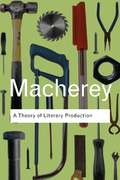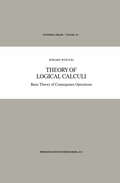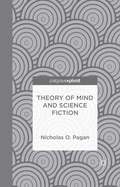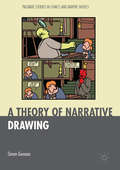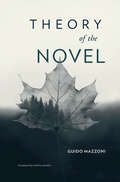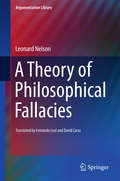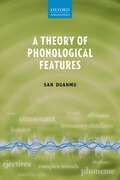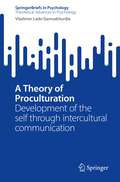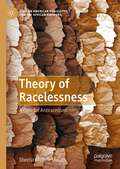- Table View
- List View
A Theory of Cognitive Dissonance (The Macat Library)
by Camille Morvan Alexander O’ConnorLeon Festinger’s 1957 A Theory of Cognitive Dissonance is a key text in the history of psychology – one that made its author one of the most influential social psychologists of his time. It is also a prime example of how creative thinking and problem solving skills can come together to produce work that changes the way people look at questions for good. Strong creative thinkers are able to look at things from a new perspective, often to the point of challenging the very frames in which those around them see things. Festinger was such a creative thinker, leading what came to be known as the “cognitive revolution” in social psychology. When Festinger was carrying out his research, the dominant school of thought – behaviorism – focused on outward behaviors and their effects. Festinger, however, turned his attention elsewhere, looking at “cognition:” the mental processes behind behaviors. In the case of “cognitive dissonance”, for example, he hypothesized that apparently incomprehensible or illogical behaviors might be caused by a cognitive drive away from dissonance, or internal contradiction. This perspective, however, raised a problem: how to examine and test out cognitive processes. Festinger’s book records the results of the psychological experiments he designed to solve that problem. The results helped prove the existence for what is now a fundamental theory in social psychology.
Theory of Complementation in English Syntax (Routledge Library Editions: Syntax)
by Joan BresnanThe subject of this study, first published in 1979, is the role of the complementizer in English syntax and its implications for syntactic theory. It is argued that the familiar transformational treatment of complementizers is inadequate, and that they must be specified in deep structure by means of a Phrase Structure rule. This title will be of interest to students of language and linguistics.
Theory of Complementation in English Syntax (Routledge Library Editions: Syntax)
by Joan BresnanThe subject of this study, first published in 1979, is the role of the complementizer in English syntax and its implications for syntactic theory. It is argued that the familiar transformational treatment of complementizers is inadequate, and that they must be specified in deep structure by means of a Phrase Structure rule. This title will be of interest to students of language and linguistics.
A Theory of Contemporary Rhetoric
by Richard AndrewsA Theory of Contemporary Rhetoric describes, explains, and argues the overarching theory of contemporary rhetoric. This current view of rhetoric brings together themes in the communication arts, including political literary criticism; bi- and multi-lingualism; multimodality; framing as an artistic and sociological device for composition and interpretation; literacy in the digital age; and the division between fiction and ‘non-fiction’ in language/literature studies. Chapters explore the implications of rhetoric for particular aspects of the field. Discussions throughout the book provide illustrations that ground the material in practice. As an overarching theory in the communication arts, rhetoric is elegant as a theoretical solution and simple as a practical one. It asks such questions as who is speaking/writing/composing? to whom? why? what is being conveyed? and how is it being conveyed? Acknowledging the dirth of recent works addressing the theory of rhetoric, this book aims to fill the existing theoretical gap and at the same time move the field of language/literature studies forward into new territory. It provides the keynote theoretical guide for a generation of teachers, teacher educators and researchers in the fields of English as a subject; English as a second, foreign or additional language; and language study in general.
A Theory of Contemporary Rhetoric
by Richard AndrewsA Theory of Contemporary Rhetoric describes, explains, and argues the overarching theory of contemporary rhetoric. This current view of rhetoric brings together themes in the communication arts, including political literary criticism; bi- and multi-lingualism; multimodality; framing as an artistic and sociological device for composition and interpretation; literacy in the digital age; and the division between fiction and ‘non-fiction’ in language/literature studies. Chapters explore the implications of rhetoric for particular aspects of the field. Discussions throughout the book provide illustrations that ground the material in practice. As an overarching theory in the communication arts, rhetoric is elegant as a theoretical solution and simple as a practical one. It asks such questions as who is speaking/writing/composing? to whom? why? what is being conveyed? and how is it being conveyed? Acknowledging the dirth of recent works addressing the theory of rhetoric, this book aims to fill the existing theoretical gap and at the same time move the field of language/literature studies forward into new territory. It provides the keynote theoretical guide for a generation of teachers, teacher educators and researchers in the fields of English as a subject; English as a second, foreign or additional language; and language study in general.
The Theory of Criticism: A Tradition and Its System
by Murray KriegerRepresenting years of critical reflection, The Theory of Criticism attempts to construct a poetics of "presence." Within a wide range of critical terminology, Murray Krieger has sought to create a new vision. In language that is passionate and often dramatic, he looks at the multidimensionality of the poetic world through the lens of Western poetics. His work clearly addresses itself to post–New Critical questions: how to preserve the literary object as a thing to be perceived, valued, and enjoyed and yet to account for its presence in, and interaction with, our culture as a whole, always in danger of being dissolved into man's language-making and -forming activity in general. Our awareness of the poem as object must be modified by our awareness that it is an "intentional" object. Krieger develops his balanced vision in three parts. The first part defines the problem and defends the very activity of theorizing both in its own terms and in terms of the critic's function throughout the history of Western criticism. By asking at the outset whether criticism is vain or valuable, Krieger already confronts the basic tension between system and world and the need to account for both. By creating a heuristic system that examines the possibility of form, the critic serves also the world of history and thought as a whole. The second part pursues that history from the classical encounter with mimesis in Greek thought to the Romantic and post-Romantic elevation of consciousness as a main criterion of poetic art. Defining a "humanistic aesthetic" as it has been viewed since Aristotle, the author shows how, during and after the eighteenth century, form was opened up under the impact of a Kantian and post-Kantian view, epitomized finally by Coleridge's imagination and its consequences for recent theorists. The third part deals with the image of the world struggling against its enclosure within a poetic context. It expands our view of metaphor as a reflection of the dual nature of poetic language, simultaneously locked into the poem and referring to history and nature outside. Our reading of the poem, Krieger concludes, must be double: we must see the poem as a linear and chronological sequence reflecting real life, and we must read it as a circular, imitative, mutually implicative mode.
The Theory of Criticism: A Tradition and Its System
by Murray KriegerOriginally published in 1976. Representing years of critical reflection, The Theory of Criticism attempts to construct a poetics of "presence." Within a wide range of critical terminology, Murray Krieger has sought to create a new vision. In language that is passionate and often dramatic, he looks at the multidimensionality of the poetic world through the lens of Western poetics. His work clearly addresses itself to post–New Critical questions: how to preserve the literary object as a thing to be perceived, valued, and enjoyed and yet to account for its presence in, and interaction with, our culture as a whole, always in danger of being dissolved into man's language-making and -forming activity in general. Our awareness of the poem as object must be modified by our awareness that it is an "intentional" object. Krieger develops his balanced vision in three parts. The first part defines the problem and defends the very activity of theorizing both in its own terms and in terms of the critic's function throughout the history of Western criticism. By asking at the outset whether criticism is vain or valuable, Krieger already confronts the basic tension between system and world and the need to account for both. By creating a heuristic system that examines the possibility of form, the critic serves also the world of history and thought as a whole. The second part pursues that history from the classical encounter with mimesis in Greek thought to the Romantic and post-Romantic elevation of consciousness as a main criterion of poetic art. Defining a "humanistic aesthetic" as it has been viewed since Aristotle, the author shows how, during and after the eighteenth century, form was opened up under the impact of a Kantian and post-Kantian view, epitomized finally by Coleridge's imagination and its consequences for recent theorists. The third part deals with the image of the world struggling against its enclosure within a poetic context. It expands our view of metaphor as a reflection of the dual nature of poetic language, simultaneously locked into the poem and referring to history and nature outside. Our reading of the poem, Krieger concludes, must be double: we must see the poem as a linear and chronological sequence reflecting real life, and we must read it as a circular, imitative, mutually implicative mode.
The Theory of Criticism: A Tradition and Its System
by Murray KriegerOriginally published in 1976. Representing years of critical reflection, The Theory of Criticism attempts to construct a poetics of "presence." Within a wide range of critical terminology, Murray Krieger has sought to create a new vision. In language that is passionate and often dramatic, he looks at the multidimensionality of the poetic world through the lens of Western poetics. His work clearly addresses itself to post–New Critical questions: how to preserve the literary object as a thing to be perceived, valued, and enjoyed and yet to account for its presence in, and interaction with, our culture as a whole, always in danger of being dissolved into man's language-making and -forming activity in general. Our awareness of the poem as object must be modified by our awareness that it is an "intentional" object. Krieger develops his balanced vision in three parts. The first part defines the problem and defends the very activity of theorizing both in its own terms and in terms of the critic's function throughout the history of Western criticism. By asking at the outset whether criticism is vain or valuable, Krieger already confronts the basic tension between system and world and the need to account for both. By creating a heuristic system that examines the possibility of form, the critic serves also the world of history and thought as a whole. The second part pursues that history from the classical encounter with mimesis in Greek thought to the Romantic and post-Romantic elevation of consciousness as a main criterion of poetic art. Defining a "humanistic aesthetic" as it has been viewed since Aristotle, the author shows how, during and after the eighteenth century, form was opened up under the impact of a Kantian and post-Kantian view, epitomized finally by Coleridge's imagination and its consequences for recent theorists. The third part deals with the image of the world struggling against its enclosure within a poetic context. It expands our view of metaphor as a reflection of the dual nature of poetic language, simultaneously locked into the poem and referring to history and nature outside. Our reading of the poem, Krieger concludes, must be double: we must see the poem as a linear and chronological sequence reflecting real life, and we must read it as a circular, imitative, mutually implicative mode.
The Theory of Descriptions: Russell and the Philosophy of Language (History of Analytic Philosophy)
by G. StevensThe book combines a historical and philosophical study of Russell's theory of descriptions. It defends, develops and extends the theory as a contribution to natural language semantics while also arguing for a reassessment of the important of linguistic inquiry to Russell's philosophical project.
A Theory of Ellipsis
by Marjorie J. McShaneEllipsis is the non-expression of one or more sentence elements whose meaning can be reconstructed either from the context or from a person's knowledge of the world. In speech and writing, ellipsis is pervasive, contributing in various ways to the economy, speed, and style of communication. Resolving ellipsis is a particularly challenging issue in natural language processing, since not only must meaning be gleaned from missing elements but the fact that something meaningful is missing must be detected in the first place. Marjorie McShane presents a comprehensive theory of ellipsis that supports the formal, cross-linguistic description of elliptical phenomena taking into account the various factors that affect the use of ellipsis. A methodology is suggested for creating a parameter space describing and treating ellipsis in any language. Such "ellipsis profiles" of languages will serve a wide range of practical applications, including but not limited to natural language processing. In contrast to earlier work, this theory focuses not only on what can, in principle, be elided but in what circumstances a given category actually would or would not be elided--that is, what renders ellipsis mandatory or infelicitous. A theory of ellipsis has been elusive because to produce an adequate account of this ubiquitous phenomenon one needs to address and integrate data from a wide variety of linguistic research areas. Using data primarily from Russian, English, and Polish, McShane looks at the big picture of ellipsis, integrating the syntactic, semantic, morphological, and pragmatic heuristics and bridges work on ellipsis with the larger study of reference. This is groundbreaking linguistic scholarship that bridges the theoretical and the applied, and will interest scholars in the fields of computational, descriptive, and theoretical linguistics.
A Theory of Freedom: Feminism and the Social Contract (Breaking Feminist Waves)
by S. WelchThis book offers a liberatory conception of individual freedom that uniquely responds to the problems of social oppression and demands of the interrelatedness insofar as it pertains specifically to the social domain of activity.
A Theory of Human Motivation (The Macat Library)
by Stoyan StoyanovUS psychologist Abraham H. Maslow’s A Theory of Human Motivation is a classic of psychological research that helped change the field for good. Like many field-changing thinkers, Maslow was not just a talented researcher, he was also a creative thinker – able to see things from a new perspective and show them in a different light. At a time when psychology was dominated by two major schools of thought, Maslow was able to forge a new, third paradigm, that remains influential today. Sigmund Freud’s psychoanalysis had developed the idea of understanding the mind through dialogue between patient and analyst. The behaviorism of Ivan Pavlov and John Watson had focused on comprehending the mind through behaviors that could be measured, trained, and changed. Maslow, however, generated new ideas, forging what he called “positive” or “humanistic psychology”. His argument was that humans are psychologically motivated by a series of hierarchical needs, starting with the most essential first. Maslow thought it important for the advancement of psychology to identify, group and rank these needs in terms of priority. His belief in the value of this third way was important in leading those who studied psychology to redefine the discipline, and so see it in new ways.
A Theory of Imagining, Knowing, and Understanding (SpringerBriefs in Psychology)
by Luca TateoThis is a book about imaginative work and its relationship with the construction of knowledge. It is fully acknowledged by epistemologists that imagination is not something opposed to rationality; it is not mere fantasy opposed to intellect. In philosophy and cognitive sciences, imagination is generally “delimiting not much more than the mental ability to interact cognitively with things that are not now present via the senses.” (Stuart, 2017, p. 11) For centuries, scholars and poets have wondered where this capability could come from, whether it is inspired by divinity or it is a peculiar feature of human mind (Tateo, 2017b). The omnipresence of imaginative work in both every day and highly specialized human activities requires a profoundly radical understanding of this phenomenon. We need to work imaginatively in order to achieve knowledge, thus imagination must be something more than a mere flight of fantasy. Considering different stories in the field of scientific endeavor, I will try to propose the idea that the imaginative process is fundamental higher mental function that concurs in our experiencing, knowing and understanding the world we are part of. This book is thus about a theoretical idea of imagining as constant part of the complex whole we call the human psyche. It is a story of human beings striving not only for knowledge and exploration but also striving for imagining possibilities.
The Theory of Language Holography
by Guanlian QianThis book presents a method of linking the ordered structure of the cosmos with human thoughts: the theory of language holography. In the view presented here, the cosmos is in harmony with the human body and language, and human thoughts are holographic with the cosmos at the level of language. In a word, the holographic relation is nothing more than the bridge by means of which Guanlian Qian connects the cosmos, human, and language. This is a vitally important contribution to linguistic and philosophical studies that cannot be ignored.The book has two main focus areas: outer language holography and inner language holography. These two areas constitute the core of the dynamic and holistic view put forward in the theory of language holography. The book’s main properties can be summarized into the following points: First and foremost, it is a book created in toto by a Chinese scholar devoted to pragmatics, theoretical linguistics, and philosophy of language. Secondly, the book was accepted by a top Chinese publisher and was republished the second year, which reflected its value and appeal. Thirdly, in terms of writing style, the book is characterized by succinctness and logic. As a result, it reads fluidly and smoothly without redundancies, which is not that common in linguistic or even philosophical works. Lastly, as stated by the author in the introduction, “Creation is the development of previous capacities, but it is also the generation of new ones”; this book can be said to put this concept into practice. Overall, the book offers a unique resource to readers around the world who want to know more about the truly original and innovative studies of language in Chinese academia.
The Theory of Lexical Phonology (Studies in Natural Language and Linguistic Theory #6)
by K.P. MohananA Theory of Literary Production
by Pierre MachereyWho is more important: the reader, or the writer? Originally published in French in 1966, Pierre Macherey’s first and most famous work, A Theory of Literary Production dared to challenge perceived wisdom, and quickly established him as a pivotal figure in literary theory. The reissue of this work as a Routledge Classic brings some radical ideas to a new audience, and argues persuasively for a totally new way of reading. As such, it is an essential work for anyone interested in the development of literary theory.
A Theory of Literary Production
by Pierre MachereyWho is more important: the reader, or the writer? Originally published in French in 1966, Pierre Macherey’s first and most famous work, A Theory of Literary Production dared to challenge perceived wisdom, and quickly established him as a pivotal figure in literary theory. The reissue of this work as a Routledge Classic brings some radical ideas to a new audience, and argues persuasively for a totally new way of reading. As such, it is an essential work for anyone interested in the development of literary theory.
Theory of Logical Calculi: Basic Theory of Consequence Operations (Synthese Library #199)
by Ryszard WójcickiTheory of Mind and Science Fiction
by N. PaganTheory of Mind and Science Fiction shows how theory of mind provides an exciting 'new' way to think about science fiction and, conversely, how science fiction sheds light not only on theory of mind but also empathy, morality, and the nature of our humanity.
A Theory of Narrative Drawing (Palgrave Studies in Comics and Graphic Novels)
by Simon GrennanThis book offers an original new conception of visual story telling, proposing that drawing, depictive drawing and narrative drawing are produced in an encompassing dialogic system of embodied social behavior. It refigures the existing descriptions of visual story-telling that pause with theorizations of perception and the articulation of form. The book identifies and examines key issues in the field, including: the relationships between vision, visualization and imagination; the theoretical remediation of linguistic and narratological concepts; the systematization of discourse; the production of the subject; idea and institution; and the significance of resources of the body in depiction, representation and narrative. It then tests this new conception in practice: two original visual demonstrations clarify the particular dialectic relationships between subjects and media, in an examination of drawing style and genre, social consensus and self-conscious constraint. The book’s originality derives from its clear articulation of a wide range of sources in proposing a conception of narrative drawing, and the extrapolation of this new conception in two new visual demonstrations.
Theory Of The Novel (pdf)
by Guido Mazzoni Zakiya HanafiIn his theory of the novel, Guido Mazzoni explains that novels consist of stories told in any way whatsoever about the experiences of ordinary men and women who exist as contingent beings within time and space. Novels allow readers to step into other lives and other versions of truth, each a small, local world, absolute in its particularity.
A Theory of Philosophical Fallacies (Argumentation Library #26)
by Leonard NelsonPresented as a Vorlesung in the German philosophical tradition, this book presents the most detailed account of Nelson’s method of argument analysis, celebrated by many luminaries such as Karl Popper. It was written in 1921 in opposition to the relativistic, subjectivistic and nihilistic tendencies of Nelson’s time. The book contains an exposition of a method that is a further development of Kant’s transcendental dialectics, followed by an application to the critical analysis of arguments by many famous thinkers, including Bentham, Mill, Poincaré, Leibniz, Hegel, Einstein, Bergson, Rickert, Simmel, Brentano, Stammler, Jellinek, Dingler, and Meinong. The book presents a general theory of philosophical argumentation as seen from the viewpoint of the typical fallacies committed by anybody arguing philosophically, whether professional philosophers or philosophical laypeople. Although the nature of philosophy and philosophical argumentation is one of the most recurrent objects of reflection for philosophers, this book represents the first attempt at a general theory of philosophical fallacy. According to Nelson, it is in the shape of false dilemmas that errors in reasoning always emerge, and false dilemmas are always the result of the same mechanism--the unwitting replacement of one concept for another.
A Theory of Phonological Features
by San DuanmuThis book outlines a system of phonological features that is minimally sufficient to distinguish all consonants and vowels in the languages of the world. The extensive evidence is drawn from datasets with a combined total of about 1000 sound inventories. The interpretation of phonetic transcriptions from different languages is a long-standing problem. In this book, San Duanmu proposes a solution that relies on the notion of contrast: X and Y are different sounds if and only if they contrast in some language. He focuses on a simple procedure to interpret empirical data: for each phonetic dimension, all inventories are searched in order to determine the maximal number of contrasts required. In addition, every unusual feature or extra degree of contrast is re-examined to confirm its validity. The resulting feature system is surprisingly simple: fewer features are needed than previously proposed, and for each feature, a two-way contrast is sufficient. Nevertheless, the proposal is reliable in that the notion of contrast is uncontroversial, the procedure is explicit, and the result is repeatable. The book also offers discussion of non-contrastive differences between languages, sound classes, and complex sounds such as affricates, consonant-glide units, consonant-liquid units, contour tones, pre-nasalized stops, clicks, ejectives, and implosives.
A Theory of Proculturation: Development of the self through intercultural communication (SpringerBriefs in Psychology)
by Vladimer Lado GamsakhurdiaIn each connection with new cultural contexts a new hybrid state of cultural adaptation is constructed enabling people to adjust to new conditions by creating innovative solutions for the self. This book aims to provide a brief presentation of innovative cultural psychological theory of proculturation reflecting and oriented on the understanding of semiotic and developmental dynamics of higher mental phenomena while engaging alien signs through intercultural communication. The exploration and theoretical understanding of developmental dynamics (such as self and identity construction) of people who live in immigration or multicultural, or even multi-ethnic societies, the research builds its new focus in contrasts with the acculturation theories currently present in social psychology. The theory of proculturation has been built in opposition to cross-cultural psychological theories as well as mainstream theories of acculturation research dominated by bidimensional theoretical models. Instead, this theory is constructed based on theoretical explorations which are rooted in cultural semiotics and developmental psychological paradigm on human psychology.
Theory of Racelessness: A Case for Antirace(ism) (African American Philosophy and the African Diaspora)
by Sheena Michele MasonThis book presents a skeptical eliminativist philosophy of race and the theory of racelessness, a methodological and pedagogical framework for analyzing "race" and racism. It explores the history of skeptical eliminativism and constructionist eliminativism within the history of African American philosophy and literary studies and its consistent connection with movements for civil rights. Sheena M. Mason considers how current anti-racist efforts reflect naturalist conservationist and constructionist reconstructionist philosophies of race that prevent more people from fully confronting the problem of racism, not race, thereby enabling racism to persist. She then offers a three-part solution for how scholars and people aspiring toward anti-racism can avoid unintentionally upholding racism, using literary studies as a case study to show how "race" often translates into racism itself. The theory of racelessness helps more people undo racism by undoing the belief in "race."
